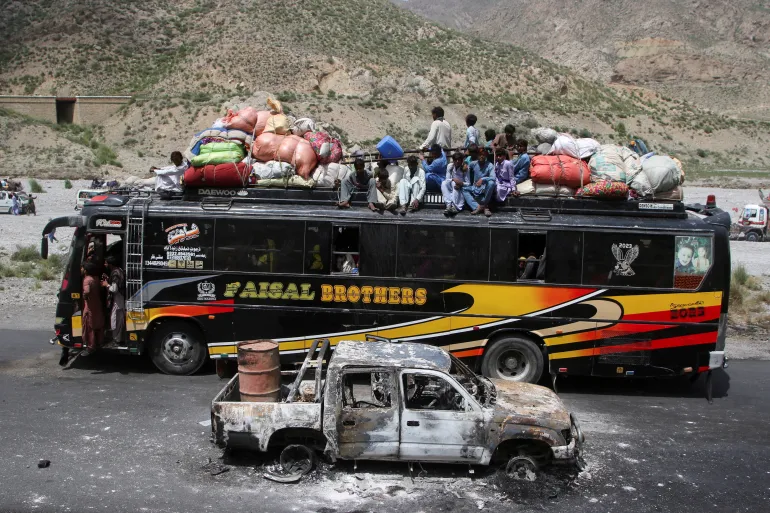As of March 27, 2025, South Asia is teetering on the edge of a broader security crisis, with Pakistan grappling with an escalating insurgency in Balochistan, India facing potential terrorist threats in Jammu and Kashmir, and Bangladesh navigating its own vulnerabilities in Dhaka and border regions. Over the past month, Pakistan has been battered by a surge in attacks led by the Balochistan Liberation Army (BLA), while sources speculate that Indian-administered Kashmir could be targeted by militants in April 2025. Meanwhile, Bangladesh, though not directly implicated, sits uneasily in this volatile neighborhood, contending with its own internal challenges that could amplify regional instability.
Pakistan’s Month of Chaos in Balochistan
Pakistan has endured a brutal month, with the BLA spearheading a wave of violence that has exposed the fragility of its security apparatus, particularly in Balochistan. On March 11, 2025, the group hijacked the Jaffar Express train in Balochistan’s Bolan Pass, holding over 400 passengers hostage for 36 hours. The ensuing military operation left 26 dead, including 18 security personnel and five civilians, with 33 BLA fighters also killed. Pakistan’s military pointed fingers at “handlers in Afghanistan” and accused India of orchestrating the attack—allegations both nations dismissed.
The violence didn’t stop there. On March 16, a roadside bomb in Noshki, Balochistan, killed five security officers, followed by twin attacks on March 22 in Kalat and Nushki that claimed eight lives. These incidents are part of a broader surge, with over 179 terror-related attacks in Pakistan in 2025 so far, resulting in 255 security force deaths, over 380 insurgent fatalities, and more than 100 civilian casualties. The BLA’s growing boldness, coupled with its recent restructuring into a “Baloch National Army,” signals an intensifying separatist threat that Pakistan’s military has struggled to contain in Balochistan.
Amid this turmoil, Pakistan has also faced speculation about external militant groups like the Arakan Army (AA) from Myanmar potentially entering the fray. While no evidence supports this as of now, the mere suggestion reflects Pakistan’s deepening paranoia as it battles multiple fronts, including tensions with Afghanistan, where border clashes have tripled since 2024.
India’s Jammu and Kashmir Under Threat
Across the border, India is bracing for its own security challenge, with unverified sources claiming that Indian-administered Jammu and Kashmir could face a wave of terrorist attacks in April 2025. These warnings, circulating in online forums and fringe commentary, lack official confirmation but align with Pakistan’s narrative of Indian interference in Balochistan. Pakistani officials, including Lieutenant General Ahmed Sharif Chaudhry, have repeatedly accused India of sponsoring the BLA, a charge New Delhi rejects as a distraction from Pakistan’s internal failures.
The prospect of renewed militancy in Jammu and Kashmir is hardly far-fetched. Groups like Lashkar-e-Taiba (LeT) and Jaish-e-Mohammad (JeM), long backed by elements within Pakistan, have targeted the region for decades. Pakistan’s current instability in Balochistan could embolden these outfits to strike in Kashmir, either independently or as a ripple effect of the BLA’s campaign. Since India revoked Kashmir’s semi-autonomous status in 2019, the region has remained a tinderbox, with a heavy military presence clashing regularly with insurgents. An April 2025 escalation would test India’s counterterrorism strategy and could reignite a broader confrontation with Pakistan, especially given the lack of diplomatic engagement between the two.
Bangladesh’s Precarious Position in Dhaka and Beyond

To the east, Bangladesh watches this unfolding crisis with growing unease from its capital, Dhaka, and its vulnerable border regions. While not directly linked to the BLA’s attacks in Balochistan or the Kashmir threat, the country is no stranger to militancy and political instability. Over the past month, Bangladesh has been relatively quiet compared to its neighbors, but its history of extremist activity—such as the 2016 Holey Artisan Bakery attack in Dhaka—and ongoing political tensions following the 2024 ouster of Sheikh Hasina’s government leave it exposed.
Bangladesh’s proximity to India and its shared border with Myanmar, where the Arakan Army operates in Rakhine State, place it in a delicate spot. The AA, though focused on Rakhine, has been name-dropped in speculative discussions about regional militancy, raising hypothetical concerns about cross-border spillover into Bangladesh’s Chittagong Hill Tracts or Cox’s Bazar. More pressingly, Bangladesh’s porous borders and strained security resources could make it a transit point or soft target if militancy spreads beyond Pakistan and India. Economic woes and a fragile interim government in Dhaka further limit the country’s ability to respond to any sudden threats.
A Regional Powder Keg
The interplay between Pakistan’s Balochistan, India’s Jammu and Kashmir, and Bangladesh’s border regions underscores a broader regional dynamic. Pakistan’s accusations of Indian support for the BLA mirror India’s claims of Pakistani backing for Kashmir-focused militants, creating a cycle of mistrust that fuels escalation. Bangladesh, while not a primary player, risks being drawn in as a secondary theater if instability spreads from Balochistan or Kashmir. The Arakan Army’s mention, though unsubstantiated, highlights how South Asia’s conflicts could intersect with Southeast Asian insurgencies, complicating an already tangled web.
For Pakistan, the immediate challenge is containing the BLA and stabilizing Balochistan, where tensions with Afghanistan exacerbate the crisis. India must prepare for a potential Kashmir flare-up while avoiding a misstep that could spark a wider conflict with Pakistan. Bangladesh faces the quieter but no less critical task of shoring up its defenses in Dhaka and beyond against any ripple effects, whether from militancy or refugee flows.
Looking Ahead
As March 2025 closes, the region stands at a crossroads. Pakistan’s security meltdown in Balochistan, driven by the BLA’s relentless campaign, shows no signs of abating. India’s vigilance in Jammu and Kashmir intensifies amid warnings of an April 2025 threat, while Bangladesh braces for indirect fallout from its vulnerable perch in Dhaka and border areas. Whether these crises remain contained or converge into a larger conflagration depends on the actions of state and non-state actors alike.
The coming weeks will be pivotal. Pakistan’s military response in Balochistan, India’s preparedness in Kashmir, and Bangladesh’s resilience in Dhaka and beyond will shape the trajectory of this regional storm. For now, South Asia holds its breath, aware that the sparks of today could ignite a firestorm tomorrow.



